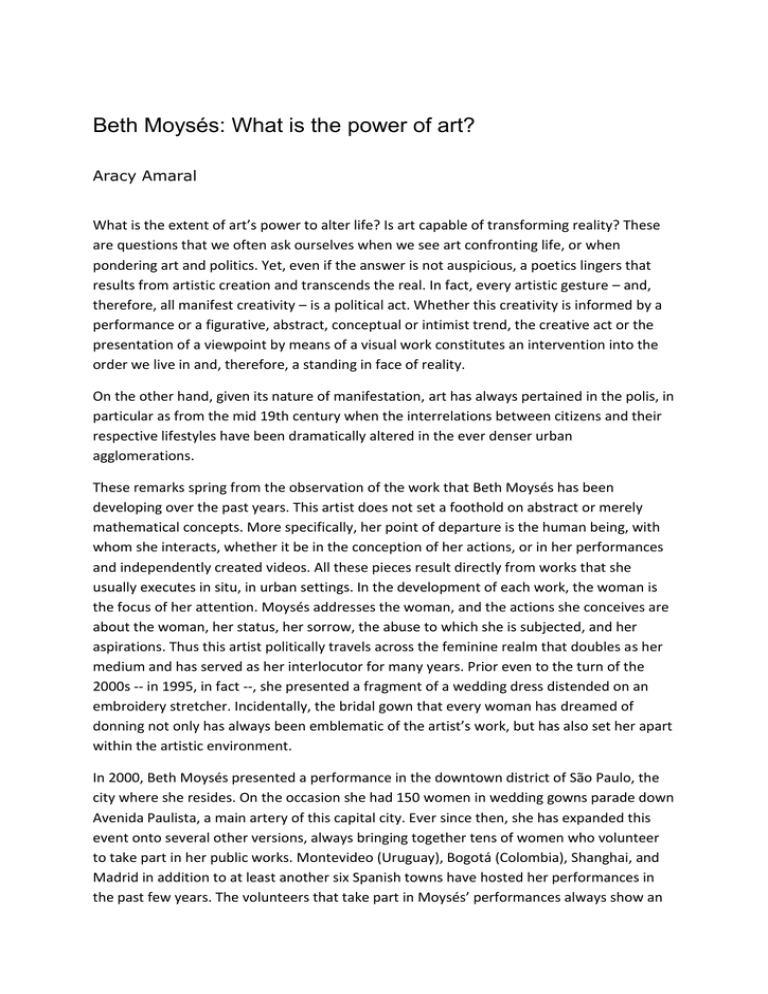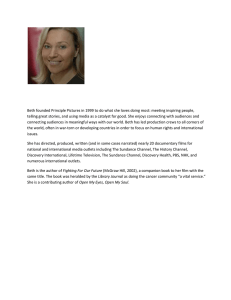Aracy Amaral 'Beth Moys s: What is the Power of Art?' text version
advertisement

Beth Moysés: What is the power of art? Aracy Amaral What is the extent of art’s power to alter life? Is art capable of transforming reality? These are questions that we often ask ourselves when we see art confronting life, or when pondering art and politics. Yet, even if the answer is not auspicious, a poetics lingers that results from artistic creation and transcends the real. In fact, every artistic gesture – and, therefore, all manifest creativity – is a political act. Whether this creativity is informed by a performance or a figurative, abstract, conceptual or intimist trend, the creative act or the presentation of a viewpoint by means of a visual work constitutes an intervention into the order we live in and, therefore, a standing in face of reality. On the other hand, given its nature of manifestation, art has always pertained in the polis, in particular as from the mid 19th century when the interrelations between citizens and their respective lifestyles have been dramatically altered in the ever denser urban agglomerations. These remarks spring from the observation of the work that Beth Moysés has been developing over the past years. This artist does not set a foothold on abstract or merely mathematical concepts. More specifically, her point of departure is the human being, with whom she interacts, whether it be in the conception of her actions, or in her performances and independently created videos. All these pieces result directly from works that she usually executes in situ, in urban settings. In the development of each work, the woman is the focus of her attention. Moysés addresses the woman, and the actions she conceives are about the woman, her status, her sorrow, the abuse to which she is subjected, and her aspirations. Thus this artist politically travels across the feminine realm that doubles as her medium and has served as her interlocutor for many years. Prior even to the turn of the 2000s -- in 1995, in fact --, she presented a fragment of a wedding dress distended on an embroidery stretcher. Incidentally, the bridal gown that every woman has dreamed of donning not only has always been emblematic of the artist’s work, but has also set her apart within the artistic environment. In 2000, Beth Moysés presented a performance in the downtown district of São Paulo, the city where she resides. On the occasion she had 150 women in wedding gowns parade down Avenida Paulista, a main artery of this capital city. Ever since then, she has expanded this event onto several other versions, always bringing together tens of women who volunteer to take part in her public works. Montevideo (Uruguay), Bogotá (Colombia), Shanghai, and Madrid in addition to at least another six Spanish towns have hosted her performances in the past few years. The volunteers that take part in Moysés’ performances always show an impressive disposition and capacity to focus on the roles attributed to them – for example, by capturing the weight of the message to be relayed and frequently touched by the subject matter of the event, with which they identify. In parallel to the urban processions, a circle or a gathering around a central point constitute frequent layouts in Beth Moysés’ performances, as if to remind us of an objective shared by the participants of each event, in the manner of radiuses that join the points of a circle with its central idea. It could be a mandala design -- a mosaic of white marble formed by the plates that each of the sixty women participating in this performance carries and sets in place in front of the Mosteiro de São Bento [St. Benedict Monastery], in São Paulo (women usually help to build their homes in the disadvantaged outskirts of large Brazilian cities); or it could be the women tracing, on their gloved hands, the essential lines of their lives (Cáceres, Spain), or yet modelling a type of sanguine dough to create works (Murcia, Spain). Nostalgia and melancholy, at times, and drama, in particular, are constant elements in environments created as a result of these poetic actions laden with sorrow, which populate Beth Moysés’ oeuvre. Such is the case, above all, in the performance “Diluídas em água” [Diluted in water] that she presented in Zaragoza and Salamanca, Spain. Here, forty women appeared dressed in white (“to me, the colour white serves to render the group action uniform,” said this artist, who is keen on having individual gestures or attitudes represent female solidarity). In this work, the reverse side of the dresses worn by twenty female residents of a shelter for abuse victims features writings done in red ink by the other women. These inscriptions include from just a few words to longer texts – in fact, one of the women used this secretive and invisible inside surface to write a letter to her abusive partner. Afterwards the performers take off the dresses and have them washed with white soap in basins. The resulting rinse water is tinted with red ink (Is blood a sign of pain?) and the clean clothing that the women put on at the end of the performance are rose-colored. Thus, the script of Beth Moysés’ works always involves an implicit allegory or a narrative that is never a chance happening. Aesthetic beauty attends her creations in the careful production of each performance and in the excellent shooting and edition of each video, such as for example in “Y Pasa”, with the colours white and red that prevail in her oeuvre once again being emphasized. In “Dripping”, a video performance in which the artist and her daughter play the parts of characters who remove, in surgically accurate manner, and then embroider pearls on a bridal gown, an alluring slowness creates an atmosphere similar to that in “Despontando nós” [Plucking knots]. In this work, the thorns being plucked one by one from long rose stems produce a subtle and intimate sound. After all, here’s what we ask ourselves while pondering the work of Beth Moysés, which reveals a tacit complicity with the female characters who accept to join her in her events: Is “being a woman” so painful and sorrowful? Actually, in the course of centuries, religions and cultures, women have appeared as ancillary characters or supporting actors, never as agents. To date, the ignominious female circumcision practiced in Islamic cultures; the forced slavery in Asian and Middle Eastern countries, where women are not allowed to study or choose their mate; the domestic or international white slave traffic; the violence and the sexual abuse against women in our day and age, often practiced by relatives or with their consent, all these are explicit demonstrations of the fact that, across the social strata, women continue to be treated with unleashed disrespect as human beings and citizens entitled the same dignity as men. Proof of this is found in the performance “Removing pain”, which the artist is presenting in Ireland and that addresses, in a particular manner, the aggressions against the female being, not in the course of history, but right in the 21st century. After symbolically “effacing” the marks of physical abuse, the cloth used to delete the signs of a woman’s suffering is buried. Subsequently rice is sowed around it in a circle, alluding to the seeding of a future production, a token of optimism and hope that nurtures humankind. Thus, far from being a poetic license and a fantasy of recurrent loss, Beth Moysés’ work is a mobilizing act that clearly exposes the status of women with the gentleness that characterizes her visual creative process, while drawing attention to the fear lived by women who are permanently at risk throughout the world. São Paulo, September 2010





